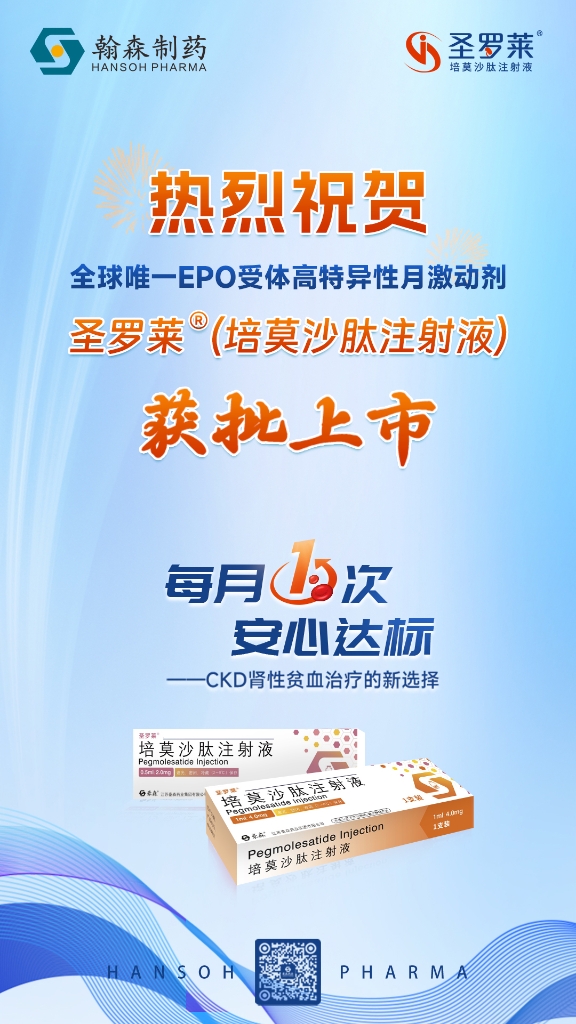On June 30, Hansoh Pharma's Saint Luolai(Pegmolesatide Injection) ,the global unique once-monthly peptide-based highly specific EPO receptor activator【PERA】,was granted approval by the National Medical Products Administration (NMPA) for marketing. This approval is for the treatment of anemia due to Chronic Kidney Disease (CKD), including adult non-dialysis patients who are not receiving Erythropoiesis Stimulating Agent (ESA) and adult dialysis patients receiving short-acting Erythropoietin (EPO). Saint Luolai now becomes the seventh innovative drug from Hansoh Pharma to receive marketing approval.

Renal anemia is a prevalent complication of CKD. Epidemiological data reveals that among Chinese adults, the prevalence of CKD stands at 10.8%, with more than 50% of cases accompanied by anemia[1]. Furthermore, the incidence of renal anemia rises as CKD advances, with an overall prevalence ranging from 28.5% to 72.0% among non-dialysis CKD patients and between 91.6% and 98.2% among those undergoing dialysis[2]. It is crucial to address anemia in individuals with kidney disease as it not only impacts their quality of life but also accelerates the progression of the disease, elevating the risks of end-stage renal disease, cardiovascular events, and mortality[2].
Insufficient production of EPO is a significant cause of renal anemia, and ESAs play a crucial role in treating this condition. Both pharmacological and clinical studies have demonstrated that Pegmolesatide has a high selectivity for EPO Receptors (EPORs). It effectively binds to EPOR homodimers, promoting erythropoiesis. Pegmolesatide exhibits comparable erythropoietic effects to traditional ESAs but demonstrates lower binding to non-erythropoietic heterodimers (EPOR + CD131), which may offer potential safety advantages. Unlike other ESAs, Pegmolesatide does not contain lysine in its molecular structure, eliminating the risk of carbamylation. Additionally, Pegmolesatide, modified with polyethylene glycol, has a significantly extended half-life compared to short-acting ESAs. This allows for once-every-4-week dosing, reducing the frequency of administration and offering greater convenience to patients while promoting treatment adherence.
According to Liu Bicheng, one of the Phase III clinical investigators of Pegmolesatide and Professor of Zhongda Hospital Southeast University, " Saint Luolai, as a Chinese original innovative drug, addresses the need for a new monthly formulation of ESAs in China and worldwide. It offers a novel treatment option for patients suffering from renal anemia, filling an important gap in the market."
"The approval of Saint Luolai is exciting. This is a successful Class 1 innovative drug developed independently by Hansoh Pharma over 15 years, and we thank the clinical experts and project team for their long-term perseverance and relay, and we look forward to witnessing the drug bring more benefits to renal anemia patients worldwide," said LYU Aifeng, Executive Director of Hansoh Pharma.
With an unwavering commitment to its original vision and embarking on a new chapter, Hansoh Pharma is dedicated to advancing its innovation-driven strategy. It aims to fulfill the clinical requirements of patients by exploring and introducing groundbreaking innovative drugs, striving to enhance the overall quality of human life.
References [1] Consensus Expert Group on the Diagnosis and Treatment of Renal Anemia of Nephrology Branch of Chinese Medical Association. Chinese Expert Consensus on the Diagnosis and Treatment of Renal Anemia (2018 Revised Edition). Chinese Journal of Nephrology, Vol. 34, No. 11, November 2018; [2] Working Group on Renal Anemia Guidelines of Chinese Nephrologist Association and Chinese Medical Doctor Association. Clinical Practice Guidelines for the Diagnosis and Treatment of Renal Anemia in China [J]. Chinese Medical Journal, June 1, 2021, Vol. 101, No. 20.
